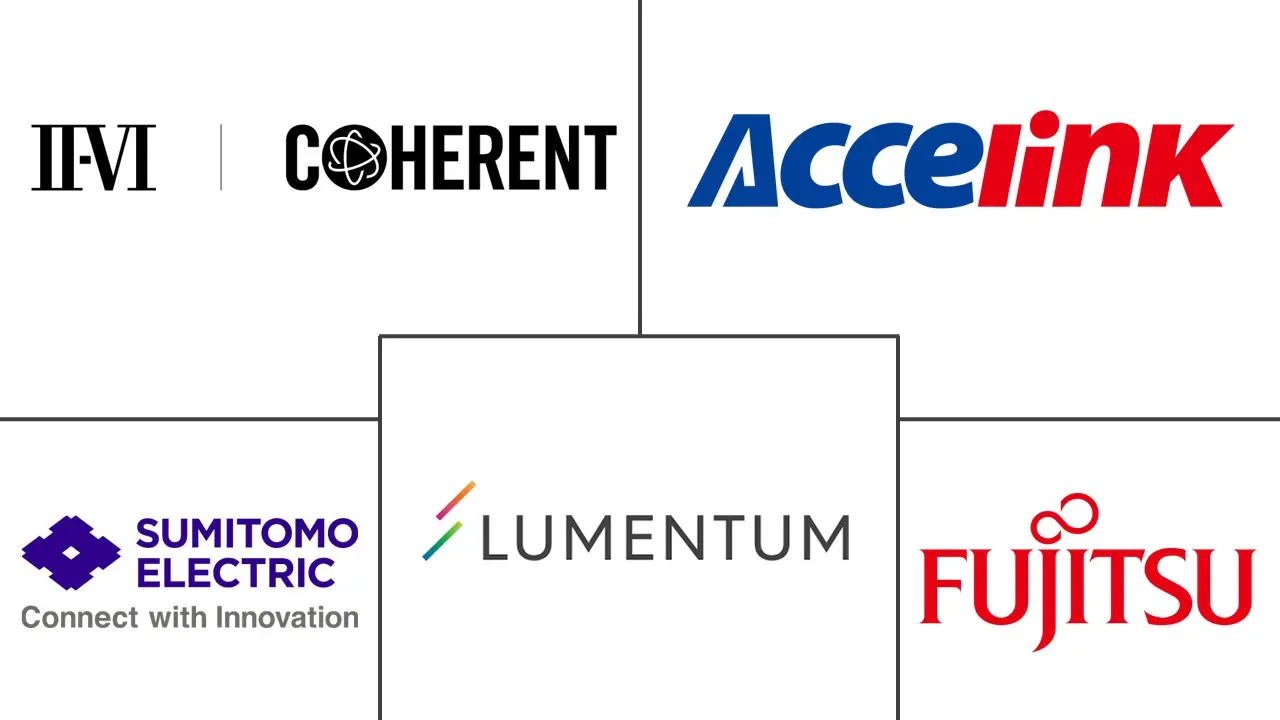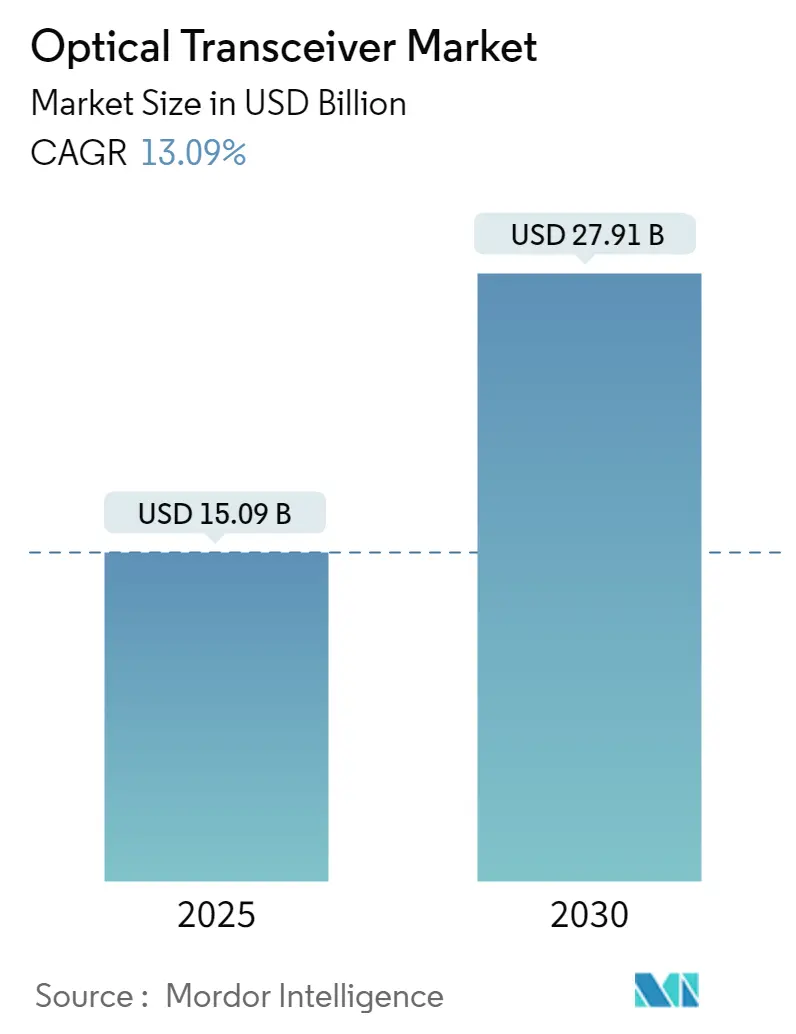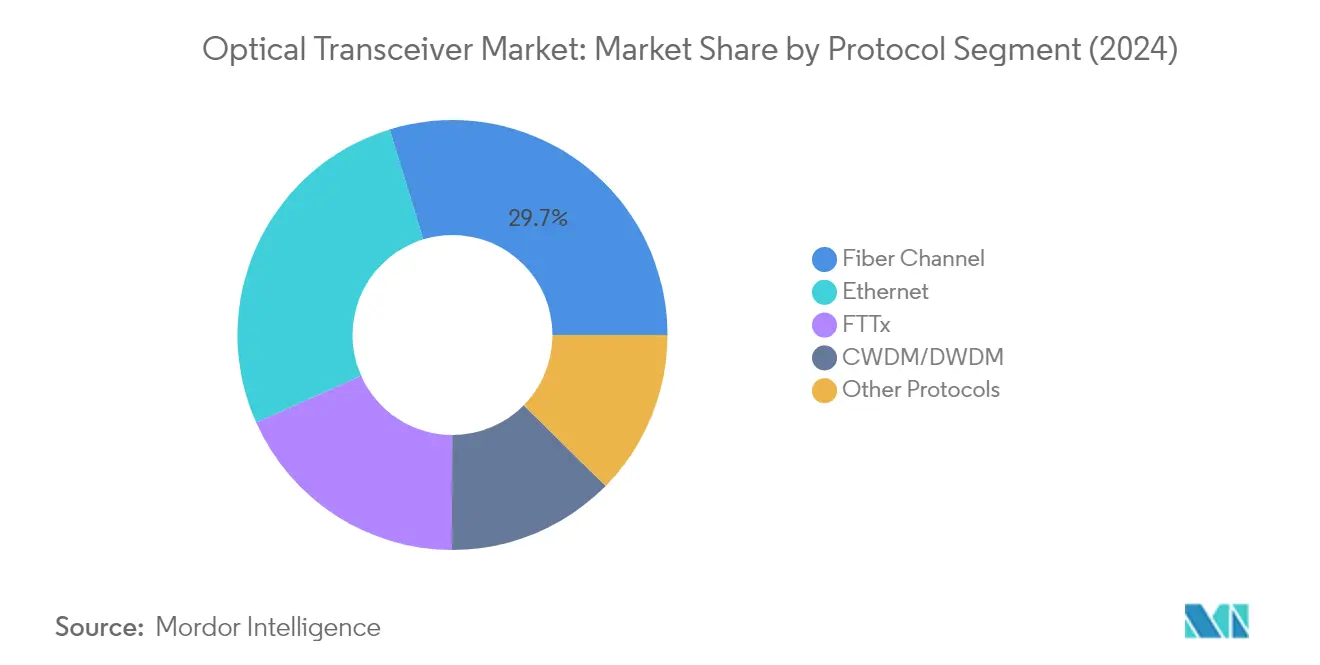Optical Transceiver Market Analysis
The Optical Transceiver Market size is estimated at USD 15.09 billion in 2025, and is expected to reach USD 27.91 billion by 2030, at a CAGR of 13.09% during the forecast period (2025-2030).
The optical transceiver industry is experiencing rapid transformation driven by the exponential growth in digital infrastructure and connectivity demands. According to Cloudscene data from September 2023, the United States leads global data center infrastructure with 5,375 facilities, followed by Germany with 522 and the United Kingdom with 517 facilities. This massive infrastructure backbone is essential to support the growing internet penetration, which has reached 91.8% in the United States as of October 2023. The increasing adoption of digital technologies and the need for high-speed connectivity are fundamentally reshaping network architectures and driving innovation in optical transmission technologies.
Major technology companies are making substantial investments in expanding their data center and cloud infrastructure capabilities. In November 2023, Microsoft announced a USD 500 million investment to expand its cloud computing and AI infrastructure in Quebec, with new data center locations planned across multiple sites. Similarly, Metro Edge has initiated agreements with construction firms to develop new data center facilities, demonstrating the industry's commitment to infrastructure expansion. These investments reflect the growing importance of robust optical communication networks in supporting next-generation digital services.
The industry is witnessing significant technological advancement in optical transceiver capabilities, particularly in terms of data transmission speeds and efficiency. Miniaturization is emerging as a crucial trend, with companies developing increasingly compact form factors. In November 2023, Avicena demonstrated what it claims to be the world's smallest 1Tbps optical transceiver at the SuperComputing Conference, showcasing the industry's push toward higher performance in smaller packages. This trend toward miniaturization while increasing performance capabilities is reshaping product development strategies across the optical transceiver market.
Strategic partnerships and technological innovations are accelerating market evolution. In December 2023, Coherent Corp. introduced its 800G ZR/ZR+ transceiver in ultracompact QSFP-DD and OSFP form factors, representing a significant advancement in optical communications networks. These developments are particularly crucial for supporting the growing demands of artificial intelligence and machine learning applications, which require increasingly sophisticated data transmission capabilities. The industry's focus on developing more efficient and powerful solutions reflects the growing complexity of modern digital infrastructure requirements.
Optical Transceiver Market Trends
Increasing Need for Advanced Communication
The telecommunications industry is experiencing unprecedented demand for advanced communication capabilities, driven by the convergence of multiple technological innovations. The deployment of 5G networks, edge computing infrastructure, and improved network architectures is creating new requirements for high-performance optical transceivers. These advancements enable faster and more reliable communication services, with optical transceivers playing a crucial role in supporting the increased bandwidth and lower latency demands of next-generation networks.
The evolution of communication networks is further accelerated by the integration of artificial intelligence and machine learning capabilities. Network operators are implementing AI-powered systems for network optimization and performance improvement, requiring more sophisticated optical transmission solutions. This trend is evidenced by recent developments such as NTT Docomo's deployment of the first 5G network utilizing graphics processing unit-accelerated wireless technology, achieved through collaboration with 13 technology companies including Nvidia Corp and Fujitsu Global. The integration of these advanced technologies is driving innovation in optical transceiver design and capabilities, pushing the boundaries of what's possible in network communication.
Increasing Demand for Cloud-based Services
Cloud-based services are experiencing exponential growth, fundamentally transforming how businesses operate and manage their IT infrastructure. The shift away from on-premises servers to cloud-based solutions is creating massive demand for high-performance optical transceivers capable of supporting increased data transmission requirements. Cloud services offer businesses the flexibility to scale resources according to demand while reducing infrastructure costs, leading to widespread adoption across industries and driving the need for more sophisticated optical communication solutions.
Data center traffic is experiencing rapid growth due to the proliferation of cloud applications, particularly in artificial intelligence, machine learning, augmented reality, and virtual reality. This growth is driving the transition to higher data rates, with the industry moving from 10G to 40G, and now to 100G and 400G transmission speeds in increasingly shorter time frames. The demand for cloud services has also led to significant infrastructure investments, as evidenced by recent developments such as Cisco's Duo establishing its first data center in India to meet customer cybersecurity and data localization demands. These investments reflect the growing importance of robust optical communication networks in supporting cloud service delivery and highlight the critical role of optical transceivers in enabling this digital transformation.
Segment Analysis: By Protocol
Fiber Channel Segment in Optical Transceiver Market
The Fiber Channel segment holds the dominant position in the global optical transceiver market, commanding approximately 30% market share in 2024. This segment's leadership is driven by its crucial role in Storage Area Networks (SANs) and high-performance computing environments. Fiber Channel transceivers connected directly to Fiber Channel switches represent one of the most effective ways to deploy SANs, offering superior performance and reliability for mission-critical applications. Many corporate and government data centers prefer Fiber Channel for critical operations due to its ability to handle synchronous mirroring and provide robust data transmission capabilities. The technology continues to evolve with innovations in enterprise storage connectivity, maintaining its position at the forefront of data center operations for shared storage connectivity.
FTTx Segment in Optical Transceiver Market
The FTTx segment is emerging as the fastest-growing segment in the optical transceiver market, projected to expand at approximately 16% CAGR from 2024 to 2029. This remarkable growth is driven by the increasing deployment of fiber-to-the-home (FTTH) and fiber-to-the-premises (FTTP) networks globally. The segment's expansion is fueled by growing demand for high-speed internet connectivity, cloud services, and digital transformation initiatives across various sectors. FTTx solutions are particularly gaining traction due to their ability to provide ultra-fast internet speeds, often reaching gigabit or higher rates, while ensuring smooth and uninterrupted data transmission. The technology's scalability and future-proof nature make it an attractive choice for telecommunications companies, cities, utilities, and real estate developers looking to upgrade their subscriber connections.
Remaining Segments in Protocol Segmentation
The optical transceiver market's protocol segmentation also includes Ethernet, CWDM/DWDM, and other protocols, each serving distinct networking requirements. Ethernet protocols are fundamental in local area networks (LAN), metropolitan area networks (MAN), and wide area networks (WAN), providing standardized connectivity solutions. The CWDM/DWDM protocols play a vital role in fiber-optic networks by enabling multiple signals to be transmitted on different wavelengths across a single fiber cable, making them essential for telecommunications and cable companies. Other protocols, including SONET, SDH, and CPRI, continue to support specific applications in telecommunications and networking infrastructure, contributing to the market's diversity and comprehensive coverage of various networking needs.
Segment Analysis: By Data Rate
100 Gbps Segment in Optical Transceiver Market
The 100 Gbps segment has emerged as the dominant force in the optical transceiver market, commanding approximately 42% market share in 2024. This segment's prominence is driven by the increasing adoption of high-speed data transmission requirements in data centers and telecommunications networks. The technology's progressive development, its surrounding ecosystem, and the lowering cost of the underlying components have added to its appeal. The segment is also experiencing the fastest growth trajectory, projected to expand at around 15% through 2024-2029, fueled by the proliferation of cloud computing, artificial intelligence, and 5G applications that demand higher bandwidth and lower latency. High-performance computing and interactive applications sensitive to throughput, such as telemedicine and high-frequency trading, are increasingly adopting 100 Gbps transceivers to ensure optimal performance and reliability.
Remaining Segments in Data Rate Segmentation
The optical transceiver market encompasses several other significant data rate segments, including Less than 10 Gbps, 10 Gbps to 40 Gbps, and Greater than 100 Gbps solutions. The 10 Gbps to 40 Gbps segment serves as a crucial intermediate solution for enterprises transitioning from lower to higher speeds, particularly in scenarios where full 100 Gbps implementation isn't immediately necessary. The Less than 10 Gbps segment continues to serve specific applications where ultra-high speeds aren't critical, while the Greater than 100 Gbps segment, including 400G and beyond, represents the cutting edge of optical module technology, catering to the most demanding applications in hyperscale data centers and advanced telecommunications networks. Each of these segments plays a vital role in meeting diverse bandwidth requirements across different applications and use cases.
Segment Analysis: By Application
Data Center Segment in Optical Transceiver Market
The data center segment has emerged as both the largest and fastest-growing segment in the optical transceiver market, commanding approximately 60% of the market share in 2024. This dominance is driven by the proliferation of data centers, which serve as the backbone of modern digital services, requiring efficient and reliable connectivity solutions. The segment's growth is fueled by the increasing adoption of cloud applications, artificial intelligence, and big data analytics, which drive the demand for high-capacity data transmission while maintaining cost efficiency and power consumption. Data centers are rapidly adopting fiber optic transceiver technology, with optical transceivers playing a crucial role in these high-capacity networks. Major cloud providers and enterprises are investing significantly in data center infrastructure, with companies like Microsoft, Google, and Amazon leading substantial expansion projects across various regions. The segment is expected to maintain its strong growth trajectory through 2024-2029, driven by the continuous evolution of data center technologies and the increasing demand for higher data rates and improved network performance.
Telecommunication Segment in Optical Transceiver Market
The telecommunication segment represents a vital component of the optical transceiver market, playing a crucial role in enabling efficient network operations through switches, routers, and overall network infrastructure. This segment is characterized by its essential role in supporting various wired networking applications, including Ethernet, SONET/Optical Transport Network (OTN), Common Public Radio Interface (CPRI), InfiniBand, and Fiber Channel. The deployment of 5G networks has been a significant driver for this segment, as these networks require high-capacity and low-latency connections. Optical transceivers are increasingly being adopted in telecommunications networks due to their ability to handle massive amounts of backhaul traffic while ensuring security and scalability. The segment's growth is further supported by government initiatives worldwide to improve digital infrastructure and expand broadband connectivity. Telecommunications companies are continuously upgrading their network infrastructure to support emerging technologies and meet the growing demand for high-speed internet connectivity, making optical transceivers an integral part of their network evolution strategy.
Optical Transceiver Market Geography Segment Analysis
Optical Transceiver Market in North America
North America represents the largest regional market for optical transceivers, commanding approximately 35% of the global optical transceiver market share in 2024. The region's dominance is primarily driven by the presence of major data center companies like Google, Microsoft, and Amazon, which are implementing high data rate optical communication equipment in their facilities. The robust adoption of advanced technologies such as artificial intelligence, 5G, IoT, and high-performance computing has created substantial demand for high data transmission rates. The region's sophisticated communication landscape, coupled with massive internet penetration, continues to fuel the need for improved optical connectivity solutions. The presence of leading technology companies and their ongoing investments in data center capacity expansions further strengthens North America's position in the global optical transceiver market. The focus on factors such as throughput, latency, simplified operations and maintenance, intelligence, and security has become major priorities for regional data center vendors, driving innovation and adoption of advanced optical transceiver solutions.
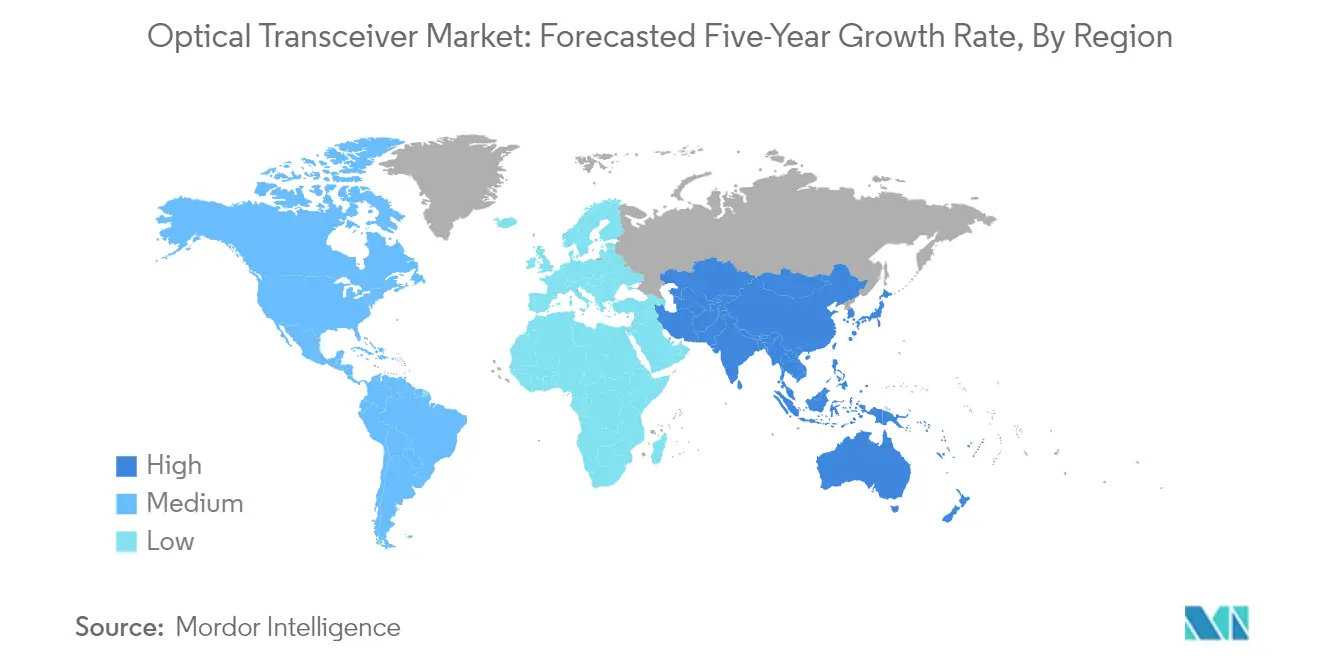
Optical Transceiver Market in Europe
Europe has established itself as a significant market for optical transceivers, demonstrating a robust growth rate of approximately 12% during 2019-2024. The region's market is characterized by increasing reliance on internet applications such as streaming videos, cloud services, social networking, and online commerce. The European market's growth is supported by significant expansion of data centers and the implementation of advanced connectivity solutions. The region has witnessed substantial investments in telecommunications infrastructure and data center facilities across major economies. European industrial and R&D firms from telecommunications and microelectronics sectors are actively developing strategic roadmaps for future connectivity systems and components. The market is further strengthened by collaborations with communities in related fields such as high-performance computing, artificial intelligence, photonics, internet of things, and cloud computing. The region's focus on sustainable and efficient communication infrastructure has created a strong foundation for continued market expansion.
Optical Transceiver Market in Asia-Pacific
The Asia-Pacific optical transceiver market is positioned for exceptional growth, with a projected CAGR of approximately 15% from 2024 to 2029. The region's market is being propelled by the rapid advancement of communication technologies and the constant evolution of telecom networks. The proliferation of IoT devices, virtual reality, and the commercial application of new technologies has accelerated the demand for data processing and information interaction capabilities. The region's market dynamics are shaped by the extensive deployment of fiber for various telecom applications, including inter-city, intra-city, FTTx, and mobile cellular systems. Government authorities across the region are actively installing fiber systems to support electric power grids, highways, railways, pipelines, airports, and data centers. The increasing adoption of smartphones and the growing internet user base have created substantial demand for high-speed and reliable optical communication module infrastructure. The market is further strengthened by the rapid development of AI, 5G, and cloud computing applications.
Optical Transceiver Market in Latin America
Latin America represents an emerging market for optical transceivers, with countries like Brazil, Mexico, and Argentina leading the regional growth. The region is experiencing a significant digital transformation that is driving the development of digital ecosystems and interconnection. The rapid proliferation of high-speed broadband connectivity and the increasing need for connected instruments are creating new opportunities in the market. The adoption of new technologies such as IoT, cloud-based services, and big data analytics is extending the need for new facilities across the region. The widespread adoption of cloud computing and increasing data traffic are emerging as crucial factors in market development. The region's telecom sector is witnessing substantial investments in optical components and experiencing rapid evolution in optical communications, indicating strong potential for future growth.
Optical Transceiver Market in Middle East & Africa
The Middle East & Africa optical transceiver market is experiencing significant growth potential, driven by the increasing adoption of 5G and cloud technologies in emerging countries. The region is witnessing rising demand for high-speed internet and data-intensive applications, creating new opportunities for optical networking devices. The growing adoption of digital technology across the industrial sector, where companies are increasing investments in technologies such as cloud, AI, and IIoT, is shaping market growth. The region's commitment to digital transformation is evident in various government initiatives and infrastructure development projects. The expansion of telecommunication networks and the increasing focus on advanced connectivity solutions are creating a favorable environment for market growth. The development of data center infrastructure and the growing emphasis on digital innovation are further contributing to the market's evolution in the region.
Optical Transceiver Market Overview
Top Companies in Optical Transceiver Market
The optical transceiver market is characterized by intense innovation and strategic developments among key players, including II-VI Incorporated, Lumentum Operations, Accelink Technologies, and Sumitomo Electric Industries. Companies are focusing on developing next-generation optical transceivers with higher data rates, improved power efficiency, and smaller form factors to meet evolving data center and telecommunications requirements. The industry witnesses continuous investment in research and development, particularly in areas like silicon photonics, indium phosphide technology, and coherent optical solutions. Market leaders are pursuing vertical integration strategies to control component manufacturing and reduce dependency on suppliers. Additionally, optical transceiver manufacturers are expanding their manufacturing capabilities across different regions while forming strategic partnerships and collaborations to enhance their technological capabilities and market presence.
Consolidated Market with Strong Global Players
The optical transceiver market demonstrates a consolidated structure dominated by large multinational corporations with extensive manufacturing capabilities and robust research and development infrastructure. These established players leverage their broad product portfolios, established distribution networks, and strong customer relationships to maintain their market positions. The market is characterized by the presence of both diversified technology conglomerates and specialized optical component manufacturers, with the former having advantages in terms of financial resources and cross-segment synergies.
The industry has witnessed significant consolidation through mergers and acquisitions, as companies seek to expand their technological capabilities and market reach. Major players are acquiring smaller innovative companies to strengthen their product offerings and gain access to new technologies and markets. This consolidation trend is particularly evident in emerging technology areas such as coherent optics and silicon photonics, where established players are looking to enhance their competitive positions through strategic acquisitions rather than internal development.
Innovation and Adaptability Drive Market Success
Success in the optical transceiver market increasingly depends on companies' ability to innovate and adapt to rapidly evolving technology standards and customer requirements. Incumbent players must maintain substantial investment in research and development while optimizing their manufacturing processes to achieve cost leadership. Companies need to focus on developing customized solutions for specific applications while maintaining standardization to achieve economies of scale. Building strong relationships with key customers in the telecommunications and data center sectors, while diversifying the customer base to reduce dependency risks, is crucial for sustainable growth.
Market contenders can gain ground by focusing on niche applications and emerging technology areas where established players may have less presence. The ability to offer specialized solutions for specific end-user requirements, combined with competitive pricing and reliable after-sales support, can help newer optical module manufacturers establish their market presence. Companies must also carefully navigate potential regulatory challenges, particularly in areas such as trade restrictions and environmental compliance. The relatively low threat of substitutes provides stability, but companies must remain vigilant about emerging technologies that could disrupt the market landscape.
Optical Transceiver Market Leaders
-
Coherent Corp. (II-VI Incorporated)
-
Accelink Technologies
-
Lumentum Operations LLC (Lumentum Holdings)
-
Sumitomo Electric Industries Ltd
-
Fujitsu Optical Components Limited (Fujitsu Ltd)
- *Disclaimer: Major Players sorted in no particular order
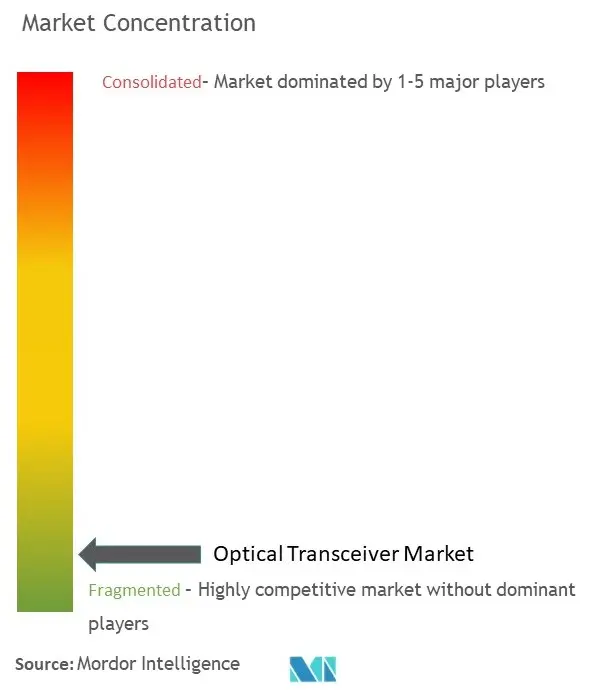
Optical Transceiver Market News
- October 2023: Broadcom and Semtech Corporation announced the demonstration of a 200 G/lane optical transceiver at the ECOC 2023, featuring Semtech’s latest Fiberdge 200 G PAM4 PMDs and Broadcom’s latest generation DSP PHY and single-mode optics.
- October 2023: II-VI Incorporated announced its demonstration of next-generation transceivers and laser technology for 800 G and 1.6T datacom transmission at ECOC 2023 in Glasgow, Scotland. Such advances are critical to sustaining the accelerating growth of the cloud driven by artificial intelligence and machine learning (AI/ML). These transceivers are used in 25 T and 50 T Ethernet switches with 100 G electrical lanes.
Optical Transceiver Market Report - Table of Contents
1. INTRODUCTION
- 1.1 Study Assumptions and Market Definition
- 1.2 Scope of the Study
2. RESEARCH METHODOLOGY
3. EXECUTIVE SUMMARY
4. MARKET INSIGHTS
- 4.1 Market Overview
- 4.2 Industry Value Chain Analysis
-
4.3 Industry Attractiveness - Porter's Five Forces Analysis
- 4.3.1 Bargaining Power of Suppliers
- 4.3.2 Bargaining Power of Buyers
- 4.3.3 Threat of New Entrants
- 4.3.4 Threat of Substitutes
- 4.3.5 Intensity of Competitive Rivalry
- 4.4 Impact of COVID-19 Aftereffects and Other Macroeconomic Factors on the Market
5. MARKET DYNAMICS
-
5.1 Market Drivers
- 5.1.1 Increasing Need for Advanced Communication
- 5.1.2 Increasing Demand for Cloud-based Services
-
5.2 Market Restraints
- 5.2.1 Increase in Network Complexity
6. MARKET SEGMENTATION
-
6.1 By Protocol
- 6.1.1 Ethernet
- 6.1.2 Fiber Channel
- 6.1.3 CWDM/DWDM
- 6.1.4 FTTX
- 6.1.5 Other Protocols
-
6.2 By Data Rate
- 6.2.1 Less than 10 Gbps
- 6.2.2 10 Gbps to 40 Gbps
- 6.2.3 100 Gbps
- 6.2.4 Greater than 100 Gbps
-
6.3 By Application
- 6.3.1 Data Center
- 6.3.2 Telecommunication
-
6.4 By Geography***
- 6.4.1 North America
- 6.4.2 Europe
- 6.4.3 Asia
- 6.4.4 Australia and New Zealand
- 6.4.5 Latin America
- 6.4.6 Middle East and Africa
7. COMPETITIVE LANDSCAPE
-
7.1 Company Profiles*
- 7.1.1 Coherent Corp. (II-VI Incorporated)
- 7.1.2 Accelink Technologies
- 7.1.3 Lumentum Operations LLC (Lumentum Holdings)
- 7.1.4 Sumitomo Electric Industries Ltd
- 7.1.5 Fujitsu Optical Components Limited (Fujitsu Ltd)
- 7.1.6 Smiths Interconnect (Reflex Photonics Inc.)
- 7.1.7 Source Photonics (Redview Capital)
- 7.1.8 Huawei Technologies Co. Ltd
- 7.1.9 Broadcom Inc.
- 7.1.10 HUBER+SUHNER Cube Optics
8. INVESTMENT ANALYSIS
9. MARKET OPPORTUNITIES AND FUTURE TRENDS
Optical Transceiver Market Industry Segmentation
An optical transceiver combines the functions of a transmitter and a receiver into a single device. Optical transceivers convert the electrical signal from a switch or router to an optical signal that can be transmitted and received in light pulses using fiber optic technology. This is accomplished at extremely high speeds and over large distances. It can be inserted into or implanted into another device that can send and receive data in a data network.
The optical transceiver market is segmented by protocol (ethernet, fiber channel, CWDM/DWDM, FTTX, other protocols), by data rate (less than 10 Gbps, 10 Gbps to 40 Gbps, 100 Gbps, greater than 100 Gbps), by application (data center, telecommunication), by geography (North America, Europe, Asia Pacific, Latin America, and the Middle East and Africa). The market sizes and forecasts are provided in terms of value in USD for all the above segments.
| By Protocol | Ethernet |
| Fiber Channel | |
| CWDM/DWDM | |
| FTTX | |
| Other Protocols | |
| By Data Rate | Less than 10 Gbps |
| 10 Gbps to 40 Gbps | |
| 100 Gbps | |
| Greater than 100 Gbps | |
| By Application | Data Center |
| Telecommunication | |
| By Geography*** | North America |
| Europe | |
| Asia | |
| Australia and New Zealand | |
| Latin America | |
| Middle East and Africa |
Optical Transceiver Market Research FAQs
How big is the Optical Transceiver Market?
The Optical Transceiver Market size is expected to reach USD 15.09 billion in 2025 and grow at a CAGR of 13.09% to reach USD 27.91 billion by 2030.
What is the current Optical Transceiver Market size?
In 2025, the Optical Transceiver Market size is expected to reach USD 15.09 billion.
Who are the key players in Optical Transceiver Market?
Coherent Corp. (II-VI Incorporated), Accelink Technologies, Lumentum Operations LLC (Lumentum Holdings), Sumitomo Electric Industries Ltd and Fujitsu Optical Components Limited (Fujitsu Ltd) are the major companies operating in the Optical Transceiver Market.
Which is the fastest growing region in Optical Transceiver Market?
Asia Pacific is estimated to grow at the highest CAGR over the forecast period (2025-2030).
Which region has the biggest share in Optical Transceiver Market?
In 2025, the North America accounts for the largest market share in Optical Transceiver Market.
What years does this Optical Transceiver Market cover, and what was the market size in 2024?
In 2024, the Optical Transceiver Market size was estimated at USD 13.11 billion. The report covers the Optical Transceiver Market historical market size for years: 2019, 2020, 2021, 2022, 2023 and 2024. The report also forecasts the Optical Transceiver Market size for years: 2025, 2026, 2027, 2028, 2029 and 2030.
Our Best Selling Reports
Optical Transceiver Market Research
Mordor Intelligence provides comprehensive industry analysis and market insights for the optical transceiver market, delivering detailed assessments of optical module vendors, technology trends, and competitive dynamics. Our research encompasses the entire ecosystem, from data center transceivers to industrial transceivers, offering stakeholders a thorough understanding of market segments, growth drivers, and emerging opportunities. The detailed market forecast, industry statistics, and competitive analysis are available in an easy-to-read report PDF format, enabling businesses to make informed decisions in the rapidly evolving optical networking equipment landscape.
Our consulting expertise extends beyond traditional market research, offering specialized services tailored to the optical component market and optical interconnect segments. We assist stakeholders with technology scouting to identify emerging innovations in photonic transceivers and optical communication modules, conduct detailed patent analyses for optical networking solutions, and provide comprehensive competition assessment of optical transceiver manufacturers. Our team excels in analyzing customer needs and behavior patterns in various application segments, from telecommunications to data centers, while also supporting businesses with product positioning strategies and new product launch tracking in the dynamic optical networking device ecosystem.

